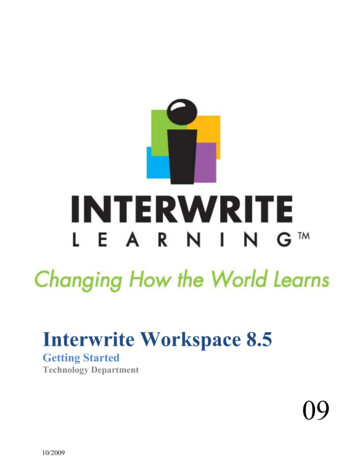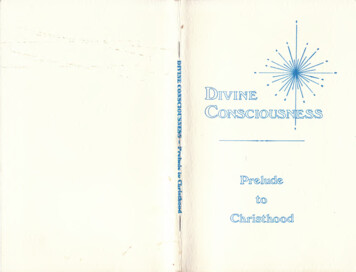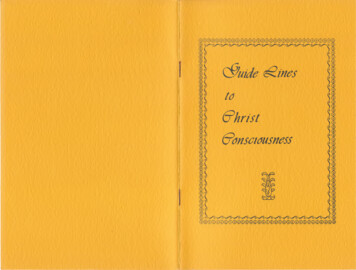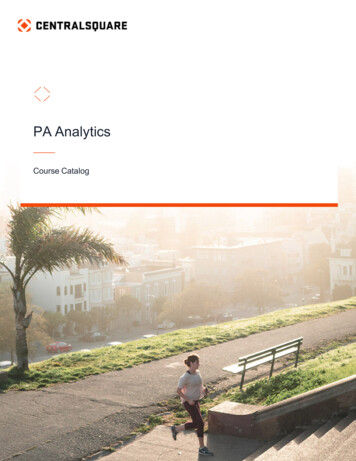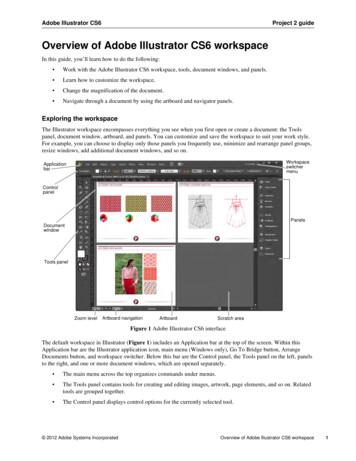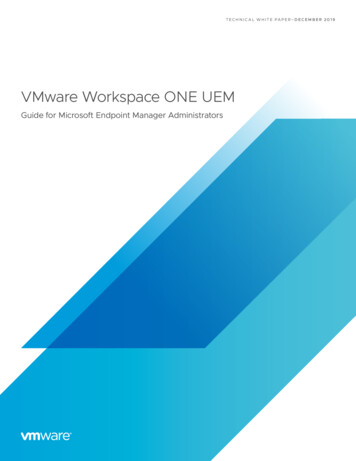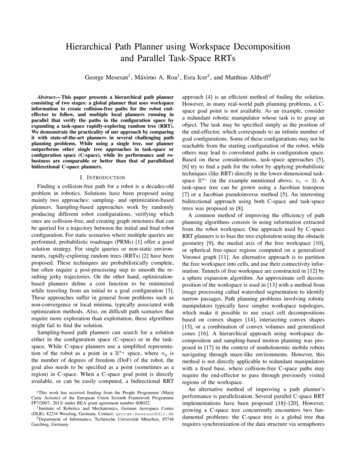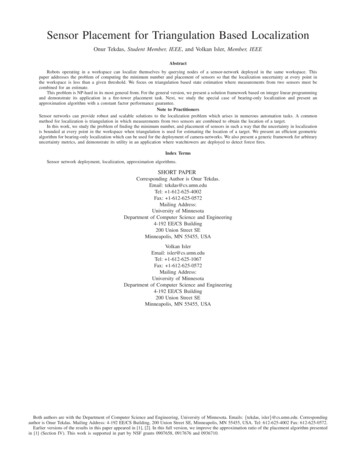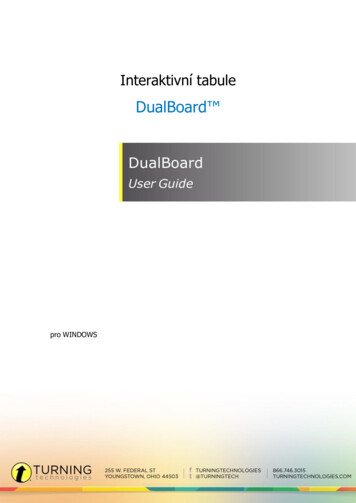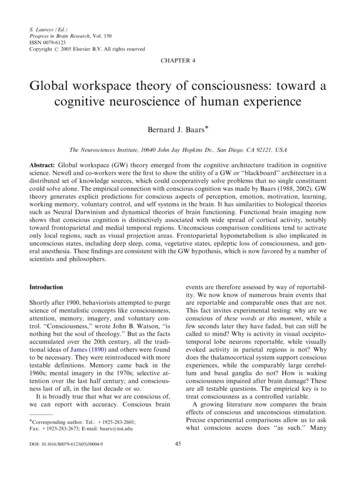
Transcription
S. Laureys (Ed.)Progress in Brain Research, Vol. 150ISSN 0079-6123Copyright r 2005 Elsevier B.V. All rights reservedCHAPTER 4Global workspace theory of consciousness: toward acognitive neuroscience of human experienceBernard J. Baars The Neurosciences Institute, 10640 John Jay Hopkins Dv., San Diego, CA 92121, USAAbstract: Global workspace (GW) theory emerged from the cognitive architecture tradition in cognitivescience. Newell and co-workers were the first to show the utility of a GW or ‘‘blackboard’’ architecture in adistributed set of knowledge sources, which could cooperatively solve problems that no single constituentcould solve alone. The empirical connection with conscious cognition was made by Baars (1988, 2002). GWtheory generates explicit predictions for conscious aspects of perception, emotion, motivation, learning,working memory, voluntary control, and self systems in the brain. It has similarities to biological theoriessuch as Neural Darwinism and dynamical theories of brain functioning. Functional brain imaging nowshows that conscious cognition is distinctively associated with wide spread of cortical activity, notablytoward frontoparietal and medial temporal regions. Unconscious comparison conditions tend to activateonly local regions, such as visual projection areas. Frontoparietal hypometabolism is also implicated inunconscious states, including deep sleep, coma, vegetative states, epileptic loss of consciousness, and general anesthesia. These findings are consistent with the GW hypothesis, which is now favored by a number ofscientists and philosophers.events are therefore assessed by way of reportability. We now know of numerous brain events thatare reportable and comparable ones that are not.This fact invites experimental testing: why are weconscious of these words at this moment, while afew seconds later they have faded, but can still becalled to mind? Why is activity in visual occipitotemporal lobe neurons reportable, while visuallyevoked activity in parietal regions is not? Whydoes the thalamocortical system support consciousexperiences, while the comparably large cerebellum and basal ganglia do not? How is wakingconsciousness impaired after brain damage? Theseare all testable questions. The empirical key is totreat consciousness as a controlled variable.A growing literature now compares the braineffects of conscious and unconscious stimulation.Precise experimental comparisons allow us to askwhat conscious access does ‘‘as such.’’ ManyIntroductionShortly after 1900, behaviorists attempted to purgescience of mentalistic concepts like consciousness,attention, memory, imagery, and voluntary control. ‘‘Consciousness,’’ wrote John B. Watson, ‘‘isnothing but the soul of theology.’’ But as the factsaccumulated over the 20th century, all the traditional ideas of James (1890) and others were foundto be necessary. They were reintroduced with moretestable definitions. Memory came back in the1960s; mental imagery in the 1970s; selective attention over the last half century; and consciousness last of all, in the last decade or so.It is broadly true that what we are conscious of,we can report with accuracy. Conscious brain Corresponding author. Tel.: 1925-283-2601;Fax: 1925-283-2673; E-mail: baars@nsi.eduDOI: 10.1016/S0079-6123(05)50004-945
46techniques are used for this purpose. In visualbackward masking, a target picture is immediatelyfollowed by a scrambled image that does not blockthe optical input, but renders it unconscious(Dehaene et al., 2001). Binocular rivalry has beenused for the same reason: it shows that when twocompeting optical streams enter the two eyes, onlyone consistent interpretation can be consciouslyperceived at any given moment (Leopold andLogothetis, 1999). Most recently, several studieshave demonstrated inattentional blindness, inwhich paying attention to one visual flow (e.g., abouncing basketball) blocks conscious access toanother one at the very center of visual gaze (e.g.,a man walking by in a gorilla suit) (Simons andChabris, 1999). These studies generally show thatunconscious stimuli still evoke local feature activity in sensory cortex. But what is the use of makingsomething conscious if even unconscious stimuliare identified by the brain? More than a score ofstudies have shown that although unconscious visual words activate known word-processing regionsof visual cortex, the same stimuli, when conscious,trigger widespread additional activity in frontoparietal regions (e.g., Dehaene et al., 2001).A rich literature has arisen comparing consciousand unconscious brain events in sleep and waking,general anesthesia, epileptic states of absence, veryspecific damage to visual cortex, spared implicitfunction after brain damage, attentional control(also see Posner, this volume), visual imagery, inner speech, memory recall, and more (Crick andKoch, 2003). In state comparisons, significantprogress has been made in understanding epilepticloss of consciousness (Blumenfeldt and Taylor,2003; Blumenfeld, this volume), general anesthesia(Fiset et al., 2001; John et al., 2001; Alkire andFiset et al., this volume) and sleep1 (Steriade, 2001;Maquet, this volume).1At the level of cortical neurons, bursting rates do not changein deep sleep (Steriade, 2001). Rather, neurons pause togetherat o4 Hz between bursts. Synchronous pausing could disruptthe cumulative high-frequency interactions needed for wakingfunctions such as perceptual continuity, immediate memory,sentence planning, motor control, and self-monitoring. It isconceivable that other unconscious states display similar neuronal mechanisms.The global access hypothesisThe idea that consciousness has an integrativefunction has a long history. Global workspace(GW) theory is a cognitive architecture with anexplicit role for consciousness. Such architectureshave been studied in cognitive science, and havepractical applications in organizing large, parallelcollections of specialized processors, broadly comparable to the brain (Newell, 1994). In recentyears, GW theory has been found increasinglyuseful by neuroscientists. The theory suggests afleeting memory capacity that enables access between brain functions that are otherwise separate.This makes sense in a brain that is viewed as amassive parallel set of specialized processors. Insuch a system, coordination and control may takeplace by way of a central information exchange,allowing some processors — such as sensory systems in the brain — to distribute information tothe system as a whole. This solution works inlarge-scale computer architectures, which showtypical ‘‘limited capacity’’ behavior when information flows by way of a GW. A sizeable body ofevidence suggests that consciousness is the primaryagent of such a global access function in humansand other mammals (Baars, 1988, 1997, 2002). The‘‘conscious access hypothesis’’ therefore impliesthat conscious cognition provides a gateway tonumerous capacities in the brain (Fig. 1). Anumber of testable predictions follow from thisgeneral hypothesis (Table 1).A theater metaphor and brain hypothesesGW theory may be thought of as a theater ofmental functioning. Consciousness in this metaphor resembles a bright spot on the stage of immediate memory, directed there by a spotlight ofattention under executive guidance. Only thebright spot is conscious, while the rest of thetheater is dark and unconscious. This approachleads to specific neural hypotheses. For sensoryconsciousness the bright spot on stage is likely torequire the corresponding sensory projection areasof the cortex. Sensory consciousness in differentmodalities may be mutually inhibitory, within
47Fig. 1. A schematic diagram of GW theory, viewed metaphorically as a theater of mind. Conscious contents correspond to the brightspot on the stage of working memory. Once conscious, they activate many unconscious regions of the brain, including interpreters,memories, language capacities, and automatisms. In brain terms, those would be involved in certain cortical regions, hippocampus, andbasal ganglia, which are believed not to directly support conscious experiences. However, conscious cognitions themselves are alwaysshaped by unconscious contexts. Executive functions (self) may be considered as one set of such contexts (Adapted from Baars, 1997).Table 1. Theoretical claims: brain capacities enabled by conscious events1. Conscious perception enables access to widespread brain sources; unconscious sensory processing is much more limited2. Conscious perception, inner speech, and visual imagery enable working memory functions; there is no evidence for unconsciousaccess to working memory3. Conscious events enable almost all kinds of learning: episodic and explicit learning, but also implicit and skill learning4. Conscious perceptual feedback enables voluntary control over motor functions, and perhaps over any neuronal population and evensingle neurons5. Conscious contents can evoke selective mechanisms (attention) and be evoked by it6. Consciousness enables access to the ‘‘observing self’’ — executive interpreters, involving parietal and prefrontal cortexapproximately 100 ms time cycles (Baars andFranklin, 2003). Sensory cortex can be activatedinternally as well as externally, resulting in the‘‘internal senses’’ of conscious inner speech andimagery. Once a conscious sensory content is established, it is distributed widely to a decentralized‘‘audience’’ of expert networks sitting in the darkened theater, presumably using corticocortical andcorticothalamic fibers. The transfer of informationfrom conscious visual episodes to the (unconscious) hippocampal system is a clear example ofsuch distribution of conscious information in thebrain (Moscovitch, 1995). This is the primaryfunctional role of consciousness: to allow a theaterarchitecture to operate in the brain, in order tointegrate, provide access, and coordinate the functioning of very large numbers of specialized networks that otherwise operate autonomously. All
48the elements of GW theory have reasonable braininterpretations, allowing us to generate a set ofspecific, testable brain hypotheses about consciousness and its many roles in the brain. Someof these ideas have now received considerable empirical support (Baars, 2002; Baars et al., 2003).The theory has been implemented in computational and neural net models and bears a family resemblance to Neural Darwinist models(Edelman, 2003). Franklin and colleagues have implemented GW theory in large-scale computeragents, to test its functionality in complex practical tasks (Franklin, 2001). IDA (for ‘‘intelligentdistributed agent’’), the current implementationof the extended GW architecture directed byFranklin, is designed to handle a very complex artificial intelligence task normally handled bytrained human beings (also see Aleksander on machine consciousness in this volume). The particulardomain in this case is interaction between U.S.Navy personnel experts and sailors who move fromjob to job. IDA negotiates with sailors via e-mail,and is able to combine numerous regulations, sailors’ preferences, time, location and travel considerations into human-level performance. While ithas components roughly corresponding to humanperception, memory, and action control, the heartof the system is a GW architecture that allows thecontent or meanings of the messages to be widelydistributed, so that specialized programs called‘‘codelets’’ can respond with solutions to centrallyposed problems. Franklin writes that ‘‘The fleshedout global workspace theory is yielding hopefullytestable hypotheses about human cognition. Thearchitectures and mechanisms that underlie consciousness and intelligence in humans can be expected to yield information agents that learncontinuously, adapt readily to dynamic environments, and behave flexibly and intelligently whenfaced with novel and unexpected situations.’’(http://csrg.cs.memphis.edu/). Similar architectureshave been applied to difficult problems like speechrecognition. While such autonomous agent simulations do not prove that GW architectures exist inthe brain, they give an existence proof of theirfunctionality. It is worth noting that few integrativetheories of mind or brain show functional utility inapplied settings.Sensory consciousness as a test caseVisual consciousness has been studied in depth,and there is accepted evidence that visual featuresthat become conscious are identified by the brainin the ventral stream of visual cortex. There, feature-sensitive cells support visual experiences oflight, color, contrast, motion, retinal size, location,and object identity; small lesions can selectivelyabolish those conscious properties without affecting other aspects of conscious vision (Zeki, 2001;Naccache, in this volume).However, to recollect the experience of a humanface, we need the hippocampal system. To respondto it emotionally, neurons in amygdala may beactivated. But hippocampus and amygdala do notseem to support conscious contents directly(Moscovitch, 2001). Thus, the ventral visualstream, which is needed for specific conscious contents, seems to influence regions that are not.Dehaene and colleagues have shown that backward-masked visual words evoked brain activityconfined to the well-known visual word recognition areas of cortex (Dehaene et al., 2001). Identical conscious words triggered higher levels ofactivity in these areas, but more importantly, theyalso evoked far more widely distributed activity inparietal and prefrontal cortex. That result has nowbeen replicated more than a dozen times, usingdifferent brain imaging techniques and differentmethods for comparing conscious and unconscious input. Such methods have included binocular rivalry (Sheinberg and Logothetis, 1997),inattentional blindness (Rees et al., 1999), neglectand its extinction (Rees et al., 2002), and differentsense modalities, such as audition (Portas et al.,2000), pain perception (Rosen et al., 1996), andsensorimotor tasks (Haier et al., 1992; Raichleet al., 1994). In all cases, conscious sensory inputevoked wider and more intense brain activity thanidentical unconscious input.Complementary findings come from studies ofunconscious states. In deep sleep, auditory stimulation activates only primary auditory cortex(Portas et al., 2000). In vegetative states followingbrain injury, stimuli that are ordinarily loud orpainful activate only the primary sensory cortices(Laureys et al., 2000, 2002). Waking consciousness
49is apparently needed for widespread of input-driven activation to occur. These findings support thegeneral notion that conscious stimuli mobilizelarge areas of cortex, presumably to distribute information about the input.Inner speech, imagery, and working memoryBoth auditory and visual consciousness can be activated endogenously. Inner speech is a particularlyimportant source of conscious auditory-phonemicevents, and visual imagery is useful for spatialmemory and problem-solving. The areas of the lefthemisphere involved in outer speech are nowknown to be involved in inner speech as well(Paulesu et al., 1993). Likewise, mental imagery isknown to involve visual cortex (Kosslyn et al.,2001). Internally generated somatosensory imagerymay reflect emotional and motivational processes,including feelings of psychological pain, pleasure,hope, fear, sadness, etc. (Damasio, 2003). Such internal sensations may communicate to other partsof the brain via global distribution or activation.Prefrontal executive systems may sometimes control motor activities by evoking motivational imagery, broadcast from the visual cortex, to activaterelevant parts of motor cortex. Parts of the brainthat play a role in emotion may also be triggered byglobal distribution of conscious contents from sensory cortices and insular cortex. For example, theamygdala appears necessary to recognize visual facial expressions of fear and anger. Thus, manycortical regions work together to transform goalsand emotions into actions (Baars, 1988).The attentional spotlightThe sensory ‘‘bright spot’’ of consciousness involves a selective attention system, the ability ofthe theater spotlight to shine on different actors onthe stage. Like other behaviors like breathing andsmiling, attention operates under dual control,voluntary, and involuntary. Voluntary attentionalselection requires frontal executive cortex, whileautomatic selection is influenced by many areas,including the brain stem, pain systems, insularcortex, and emotional centers like the amygdalaand peri-aqueductal grey (Panksepp, 1998). Presumably, these automatic attentional systems thatallow significant stimuli to ‘‘break through’’ intoconsciousness, as when a subject’s name is sounded in an otherwise unconscious auditory source.Context and the first-person perspectiveWhen we step from a tossing sailboat onto solidground, the horizon can be seen to wobble. On anairplane flight at night passengers can see the cabintilting on approach to landing, although they arereceiving no optical cues about the direction of theplane. In those cases unconscious vestibular signals shape conscious vision. There are numerousexamples in which unconscious brain activities canshape conscious ones, and vice versa. These unconscious influences on conscious events are called‘‘contexts’’ in GW theory (Fig. 1). Any conscioussensory event requires the interaction of sensoryanalyzers and contextual systems. In vision, sensory contents seem to be produced by the ventralvisual pathway, while contextual systems in thedorsal pathway define a spatial domain withinwhich the sensory event is defined. Parietal cortexis known to include allocentric and egocentricspatial maps, which are not themselves objects ofconsciousness, but which are required to shapeevery conscious visual event. There is a differencebetween the disorders of content systems like thevisual ventral stream, compared to damaged context systems. In the case of ventral stream lesions,the subject can generally notice a missing part ofnormal experience; but for damage to context, thebrain basis of expectations is itself damaged, sothat one no longer knows what to expect, andhence what is missing. This may be why parietalneglect is so often accompanied by a striking lossof knowledge about one’s body space (Bisiach andGeminiani, 1991). Patients suffering from rightparietal neglect can have disturbing alien experiences of their own bodies, especially of the left armand leg. Such patients sometimes believe that theirleft leg belongs to someone else, often a relative,and can desperately try to throw it out of bed.Thus, parietal regions seem to shape contextuallyboth the experience of the visual world and of
50one’s own body. Notice that neglect patients stillexperience their alien limbs as conscious visualobjects (a ventral stream function); they are justdisowned. Such specific loss of contextual bodyinformation is not accompanied by a loss of general intelligence or knowledge.Vogeley and Fink (2003) suggest that parietalcortex is involved in the first-person perspective,the viewpoint of the observing self. When subjectsare asked to adopt the visual perspective of anotherperson, parietal cortex became differentially active.Self-systemsActivation by of visual object regions by the sightof a coffee cup may not be enough to generatesubjective consciousness of the cup. The activatedvisual information may need to be conveyed toexecutive or self-systems, which serve to maintainconstancy of an inner framework across perceptual situations. When we walk from room to room ina building, we must maintain a complex and multileveled organization that can be viewed in GWtheory as a higher-level context. Major goals, forexample, do not change when we walk from roomto room, but conscious perceptual experiences do.Gazzaniga (1996) has found a number of conditions under which split-brain patients encounterconflict between right and left hemisphere executive and perceptual functions. He has proposed theexistence of a ‘‘narrative self’’ in the left frontalcortex, based on split-brain patients who are clearly using speech output in the left hemisphere totalk to themselves, sometimes trying to force theright hemisphere to obey its commands. Whenthat proves impossible, the left hemisphere willoften rationalize the sequence of events so as torepair its understanding of the interhemisphericconflict. Analogous repairs of reality are observedin other forms of brain damage, such as neglect.They also commonly occur whenever humans areconfronted with major, unexpected life changes.The left-hemisphere narrative interpreter may beconsidered as a higher-level context system thatmaintains expectations and intentions across manyspecific situations. Although the inner narrativeitself is conscious, it is shaped by unconsciouscontextual influences.If we consider Gazzaniga’s narrative interpreterof the dominant hemisphere to be one kind of selfsystem in the brain, it must receive its own flow ofsensory input. Visual input from one-half of thefield may be integrated in one visual hemicortex, asdescribed above, under retinotopic control fromarea V1. But once it comes together in late visualcortex (presumably in inferotemporal object regions), it needs to be conveyed to frontal areas onthe dominant hemisphere, in order to inform thenarrative interpreter of the current state of perceptual affairs. The left prefrontal self system thenapplies a host of criteria to the input, such as ‘‘didI intend this result? Is it consistent with my currentand long-term goals? If not, can I reinterpret it tomake sense in my running account of reality?’’ It ispossible that the right hemisphere has a parallelsystem that does not speak but that may be betterable to deal with anomalies via irony, jokes, andother emotionally useful strategies. The evidenceappears to be good that the isolated right prefrontal cortex can understand such figurative uses oflanguage, while the left does not. Full consciousness may not exist without the participation ofsuch prefrontal self systems.Relevance to waking, sleeping, coma, and generalanesthesiaMetabolic activity in the conscious resting state isnot uniformly distributed. Raichle et al. (2001) reported that mesiofrontal and medial parietal areas,encompassing precuneus and adjacent posteriorcingulate cortex, can be posited as a tonically active region of the brain that may continuouslygather information about the world around, andpossibly within, us. It would appear to be a defaultactivity of the brain. Mazoyer et al. (2001) alsofound high prefrontal metabolism during rest. Wewill see that these regions show markedly lowermetabolism in unconscious states.Laureys (1999a, b, 2000) and Baars et al. (2003)list the following features of four unconsciousstates, that are causally very different from eachother: deep sleep, coma/vegetative states, epileptic
51loss of consciousness, and general anesthesia undervarious agents. Surprisingly, despite their very different mechanisms they share major common features. These include: (i) widely synchronized slowwaveforms that take the place of the fast and flexible interactions needed for conscious functions;(ii) frontoparietal hypometabolism; (iii) widelyblocked functional connectivity, both corticocortical and thalamocortical; and (iv) behavioral unconsciousness, including unresponsiveness tonormally conscious stimuli. Fig. 2 shows markedhypofunction in the four unconscious states compared with conscious controls, precisely where wemight expect it: in frontoparietal regions.In a related study, John and co-workers showedmarked quantitative electroencephalogram (EEG)2changes between conscious, anesthetic, and postanesthetic (conscious) states (John et al., 2000). Atloss of consciousness, gamma power decreasedwhile lower frequency bands increased in power,especially in frontal leads. Loss of consciousnesswas accompanied by a significant drop in coherence between homologous areas of the two hemispheres, and between posterior and anteriorregions of each hemisphere. However, there washypersynchronous activity within anterior regions.The same basic changes occurred across all six anesthetics,3 and reversed when patients regainedconsciousness (see John, in this volume).From the viewpoint of globalist theories, the mostreadily interpretable finding is the coherence drop inthe gamma range after anesthetic loss of consciousness. It suggests a loss of coordination betweenfrontal and posterior cortex, and between homologous regions of the two hemispheres. The authorsalso suggest that the anteriorization of low frequencies ‘‘must exert a profound inhibitory influence on2Although the spike-wave EEG of epileptic seizures appearsdifferent from the delta waves of deep sleep and general anesthesia, it is also synchronized, slow, and high in amplitude.The source and distribution of spike-wave activity varies indifferent seizure types. However, the more widespread thespike-wave pattern, the more consciousness is likely to be impaired (Blumenfeldt and Taylor, 2003). This is again marked infrontoparietal regions.3There is a debate whether ketamine at relatively low dosesshould be considered an anesthetic. All anesthetic agents in thisstudy were used at dosages sufficient to provide surgical-levelloss of consciousness.cooperative processes within (frontal) neuronal populations. This functional system then becomes dedifferentiated and disorganized’’ (p. 180). Finally,the decoupling of the posterior cortex with anteriorregions suggests ‘‘a blockade of perception’’ (p. 180).These phenomena appear to be consistent with theGW notion that widespread activation of nonsensory regions is required for sensory consciousness.The role of frontoparietal regions in consciouscontents and statesCould it be that brain regions that underlie thecontextual functions of Fig. 1 involve frontal andparietal regions? In everyday language, the ‘‘observing self’’ may be disabled when those regionsare dysfunctional and long-range functional connectivity is impaired. Frontoparietal associationareas have many functions, but several lines ofevidence suggest that they could have a special relationship with consciousness, even though theydo not support the sensory contents of consciousexperience directly. (i) Conscious stimulation inthe waking state leads to frontoparietal activation,but unconscious input does not; (ii) in unconsciousstates, sensory stimulation activates only sensorycortex, but not frontoparietal regions; (iii) theconscious resting state shows high frontoparietalmetabolism compared with outward-directed cognitive tasks; and (iv) four causally very differentunconscious states show marked functional decrements in the same areas. Although alternative hypotheses must be considered, it seems reasonableto suggest that ‘‘self’’ systems supported by theseregions could be disabled in unconscious states.From the viewpoint of the narrative observer, thiswould be experienced as subjective loss of accessto the conscious world. Unconscious states mightnot necessarily block the objects of consciousness;rather, the observing subject might not be at home.ConclusionGW theory suggests that consciousness enablesmultiple networks to cooperate and compete insolving problems, such as retrieval of specific itemsfrom immediate memory. Conscious contents may
52Fig. 2. Neural activity in four types of unconscious states, subtracted from conscious controls. Positron emission tomography scansshowing regional decreases in metabolism or blood flow when unconscious states are compared with resting consciousness. Coma,persistent vegetative state, sleep, and general anesthesia all show regional decreases in frontoparietal association cortices. Column 1:the right lateral aspect of the brain; column 2: the left lateral aspect; column 3: a medial view of the left hemisphere. Abbreviations: F,prefrontal; MF, mesiofrontal; P, posterior parietal cortex; Pr, posterior cingulate/precuneus (from Baars et al., 2003).correspond to brain processes that work much likebrief memories whose contents activate widespread regions in the brain. Physiologically suchinteractions seem to involve multiple high-frequency oscillatory rhythms. The overall functionof consciousness is to provide widespread access,which in turn may serve coordination and control.Consciousness is the gateway to the brain.AcknowledgmentsI gratefully acknowledge support from theNeurosciences Institute and the NeurosciencesResearch Foundation (10640 John Jay HopkinsDrive, San Diego, CA 94549, USA). Ithank Steven Laureys, Gerald M. Edelman, StanFranklin, Bjorn Merker, Anil Seth, Douglas Nitz,E. Roy John, and Walter Freeman for helpfuldiscussions.ReferencesBaars, B.J. (1988) A cognitive theory of consciousness.Cambridge University Press, New York.Baars, B.J. (1997) In the theater of consciousness: The workspace of the mind. Oxford, New York.Baars, B.J. (2002) The conscious access hypothesis: origins andrecent evidence. Trends Cogn. Sci., 6: 47–52.Baars, B. J., Ramsoy, T., Laureys, S. (2003). Trends inNeurosci., 26, 671–675.Baars, B.J. and Franklin, S. (2003) How conscious experienceand working memory interact. Trends Cogn. Sci., 7: 166–172.Bisiach, E. and Geminiani, G. (1991) Anosognosia related tohemiplegia and hemianopia. In: Prigatano G.P. and SchacterD.L. (Eds.), Awareness of Deficit After Brain Injury: Clinicaland Theoretical Issues. Oxford University Press.Blumenfeldt, H. and Taylor, J. (2003) Why do seizures causeloss of consciousness? Neuroscientist, 9: 1–10.Crick, F. and Koch, C. (2003) A framework for consciousness.Nat. Neurosci., 6: 119–126.Damasio, A. (2003) The feeling of knowing. Basic Books, NewYork.
53Dehaene, S., et al. (2001) Cerebral mechanisms of word masking and unconscious repetition priming. Natl. Neurosci., 4:752–758.Edelman, G.M. (2003) Naturalizing consciousness: a theoreticalframework. Proc. Natl. Acad. Sci. USA, 100: 5520–5534.Fiset, P., Paus, T., Daloze, T., Plo
The global access hypothesis The idea that consciousness has an integrative function has a long history. Global workspace (GW) theory is a cognitive architecture with an explicit role for consciousness. Such architectures have been studied in cognitive science, and have practical applications in organizing large, parallel
